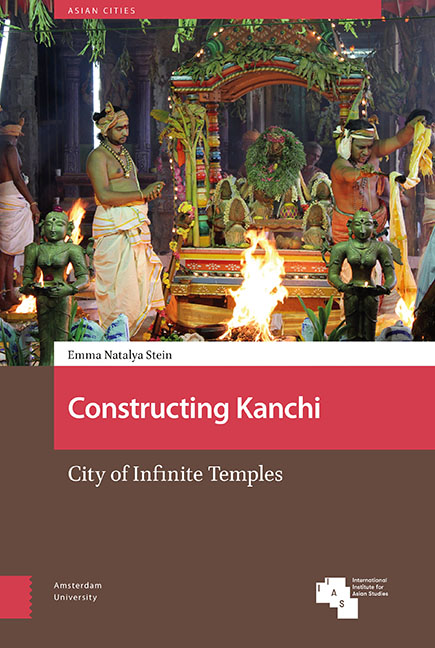Book contents
- Frontmatter
- Dedication
- Table of Contents
- Acknowledgments
- List of Illustrations
- Note on Transliteration, Translation, and Illustrations
- Introduction: All Streets Lead to Temples
- 1 Sandstone and the City: Building Pallava-Kanchi (ca. seventh through ninth century)
- 2 Realignment: Kanchi in the Chola Era (ca. tenth through thirteenth century)
- 3 The City and its Ports
- 4 Kanchi Under Colonialism
- Epilogue: The Living Temple
- Bibliography
- Index
3 - The City and its Ports
Published online by Cambridge University Press: 16 December 2021
- Frontmatter
- Dedication
- Table of Contents
- Acknowledgments
- List of Illustrations
- Note on Transliteration, Translation, and Illustrations
- Introduction: All Streets Lead to Temples
- 1 Sandstone and the City: Building Pallava-Kanchi (ca. seventh through ninth century)
- 2 Realignment: Kanchi in the Chola Era (ca. tenth through thirteenth century)
- 3 The City and its Ports
- 4 Kanchi Under Colonialism
- Epilogue: The Living Temple
- Bibliography
- Index
Summary
Abstract
Chapter Three explores the creation of a broader geographical ruralurban continuum that increasingly came to define Kanchi. It examines settlements in the rural areas surrounding the city that became home to Pallava and Chola-era sacred architecture and received subsequent endowments and modifications over time. Together, these settlements formed a devotional and economic network. The chapter traces interactions among temple-sites through shared patterns in architecture, iconography, and inscriptions, as well as residential design. The chapter's final section considers the possibility of a cultural landscape that expanded Kanchi's kṣatra (‘sphere of influence’) transregionally. Specifically, it looks at Kanchi's role in extended Buddhist networks and examines connections across urban centers in an integrated South and Southeast Asian region.
Keywords: Buddhism, Tamil merchants, Indian Ocean, Rurban, Epigraphy, Cultural landscape
The twelfth-century hagiography of Saint Tirukkuṟipput Toṇṭar opens with generous praise for the lands that surround Kanchi. The poem takes us on a journey across the hinterland, from Māmallapuram on the seacoast (‘neytal’), through Tirukkaḻukuṉṟam in the hills (‘kuṟinci’), to the farms and granaries (‘marutam’) around Vallam, and finally to the urban center (‘nagaram’) of Kanchi itself. Along the way, the Palar River is described as a source of joy. A Chola-era reader would have been familiar with these landscapes from classical, Caṅkam-era Tamil literature (ca. first century BCE-sixth century CE), which was still in circulation when the poem was composed. More than just poetic concepts, these landscapes are grounded in the actual experience of travel through Tamil Nadu.
This chapter widens the focus from Kanchi's urban core to consider the ways in which the city's hinterland was transformed over the course of the eighth through the thirteenth century (Ill. 53). As Kanchi's rulers consolidated and expanded the city, the relationship between landscapes and the built environment grew increasingly dynamic. The jungle was converted incrementally into settled terrain, and the new villages became integrated together as people traveled from place to place with ever greater degrees of frequency. Natural resources were manipulated to serve the settlements – rivers and streams were diverted to craft irrigation networks that watered the fertile tracts, and stone quarries were exploited to build temples.
- Type
- Chapter
- Information
- Constructing KanchiCity of Infinite Temples, pp. 153 - 198Publisher: Amsterdam University PressPrint publication year: 2021



